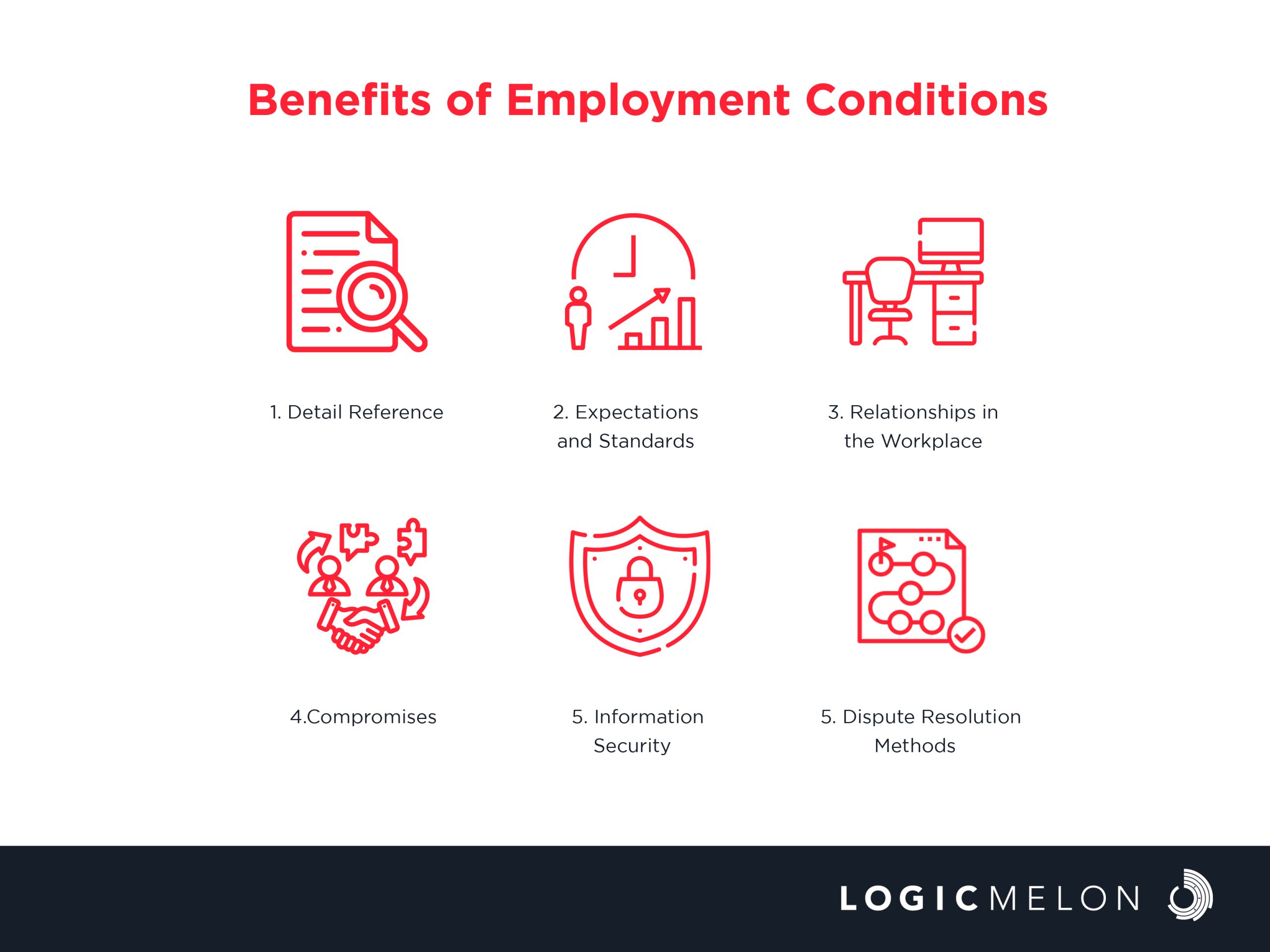Employment Conditions – A Comprehensive Guide
Employment conditions refer to the rules, requirements, and benefits connected with a specific job. This can cover everything from an employee’s pay to the dress code at their workplace and their expected work hours. Employment conditions are normally specified in a formal agreement between the employee and their employer as well as in the company’s employee handbook.
Most companies have defined general policies that apply to all employees because there are differences in the terms of employment for different positions within a company.
Who Determines the Employment Conditions?
The law and the job market have the most influence on a company’s employment policies. To compete with other companies and attract top talent from a small pool of applicants, employers are compelled by the free marketplace to offer appealing working circumstances. To influence candidates, some companies may also include a competitive compensation package in their employment policy.
According to the law, an organisation’s employment conditions must align with national employment regulations regarding employee safety, access to healthcare, and other criteria. Trade unions may assist their members to negotiate specific employment conditions in some industries. Employment conditions are often regulated by a blend of governing law and market knowledge.
What Do the Employment Conditions Include?
The following are the categories of conditions included in the employment contract:
1. Company-Specific Conditions
Conditions that apply to the company are predetermined by it. They provide an outline of how the business runs and align standards with the corporate culture. This term helps employees learn more about how the business runs. When the company grows, conditions may change. This may also include retirement plans and health insurance available to employees. The following are some of the company-specific conditions:
- Policies relating to time off from work
- Corporate holidays
- Disciplinary procedures
- Pay schedule
- Dress code regulations
- Probationary periods
- Performance review requirements
2. Job-Specific Conditions
Job-specific conditions are rules and specifications pertaining to the duties and benefits of the position. They depend on the job and can differ between employees. As these terms are frequently negotiable, individuals with in-demand abilities might work out more favourable terms. The majority of companies provide information about job-specific conditions in both the primarily written statement of terms and conditions and the job posting.
It’s important to remember that most employees have a legal limit on the amount of overtime they can work each week, and that limit varies depending on the maximum number of hours they can work. This may be set by the employer as part of the terms for overtime pay. The following are some of the job-specific conditions:
- Extra time and bonuses.
- Vacation pay.
- Severance pay.
- Compensation.
- Sick leave compensation.
3. Strong Terms
Strong terms are frequently unspoken criteria that are taken for granted in any workplace. Trust is an implied concept that is essential to building strong working connections between the employee and employer. When an employee requests time off, an employer may trust that they are actually sick, while the employee may believe that the company will respect their health insurance benefits.
Employers and employees must treat each other and other employees with respect. They collaborate to keep the workplace productive. Employees have a responsibility to follow reasonable instructions given by their employer, even though companies may offer equipment training to ensure safe operations. If this directive conflicts with the responsibilities listed in the job description or is unlawful, employees may question it.
Benefits of Employment Conditions
The benefits of having an employment contract include:

1. Detail Reference
To prevent future misunderstandings, the employee’s position is fully described in the contract. Both parties can identify the expectations of the position and understand how the role fits into larger companies. Employment contracts can be used by employers to outline various points and guidelines.
Employers can protect certain aspects of their company, such as trade secrets or materials covered by patents or copyrights, by customising agreements to include circumstantial clauses while also giving employees a clearer understanding of their rights within the workplace.
2. Expectations and Standards
Employers can set acceptable and unacceptable performance expectations for workers according to the terms of their employment contracts. Stating these norms makes it easier for people to conduct themselves professionally and feel more confident in their new position. Pre-established standards also decrease the amount of time employers must spend explaining them to staff members and correcting their behaviour.
3. Relationships in the Workplace
Positive working relationships between employers and employees are encouraged by employment agreements. This is because it gives employers the satisfaction of knowing that their staff members have a defined structure and set of goals by which to act and succeed at work. Employees can raise their level of job security and ensure work stability. This means that employment contracts create a cooperative relationship that enables both employees and employers to feel confident in new hires and to feel appreciated and guided by the company.
4. Compromises
The possibility of a scenario in which employees and employers sit down to write employment agreements opens the door to talk and compromise. Employers and employees can negotiate specific conditions or obligations within the provisions of their employment contracts. By doing this, they are able to establish a compromise that will satisfy everyone. It encourages strong working relationships and makes employees feel heard when discussing contracts and agreements prior to hiring.
5. Information Security
Companies can maintain their reputation and trade secrets by using an employment contract to safeguard this information. This is because businesses can include a confidentiality clause that ensures critical information useful to competitors is kept confidential. Additionally, confidentiality agreements stop employees from exploiting private information to compete with you if they change jobs in the future.
6. Dispute Resolution Methods
The existence of an employment agreement benefits both parties in the event of a disagreement and may even serve to prevent one. Both parties can review the employment contract to resolve differences in the terms of employment, such as pay or working hours for an employee. A written employment agreement could prevent them from asking a court or lawyer for help.
Frequently Asked Questions
1. Where Can You Find Employment Conditions?
Job ads, business policy manuals, and conditions are frequently included in the employee handbook,. Some companies prefer to reach a verbal agreement with the employee. It is always good to have written terms of employment that you can always refer to later because doing so can avoid disruption if employees and employers recall different versions of events.
2. Can Employment Conditions Change?
In general, employers can alter the employment conditions as they see fit, provided that doing so does not violate any laws. These adjustments might be anything from raising the salary to implementing paid paternity leave. Unless the employer and employee agree to renegotiate, the conditions must be followed for the duration of the contract.
Closing Thoughts
The rules, guidelines, benefits, and expectations for an employee are outlined in the employment conditions. Usually, they are outlined in an employment agreement or employee handbook. Most employees join a workplace after agreeing to the terms and conditions laid out by the company. The Department of Labor sets the criteria for terms of employment, although in most cases, employers and employees can negotiate individualised conditions of employment.
LogicMelon
Award-winning recruitment software that will find, attract, hire and analyse the way you want to work. At LogicMelon, we have experienced software recruitment marketing specialists to help you build effective recruitment solutions supported by the best customer service you’ll find anywhere!
Email: sales@logicmelon.com or call LogicMelon (UK) +44 (0) 203 553 3667 (USA) +1 860 269 3089
Recruitment Data Visualisation: Everything You Must Know
As a recruiter, you go through a lot of information daily. Recruitment data visualisation simplifies the complex data, making it easier to understand and act upon.
The Role of Soft Skills in Leadership Recruitment
In leadership development, soft skills are essential for identifying individuals who can not only manage but also inspire and guide teams to success.
ATS and CRM in Talent Acquisition
By utilising the strengths of ATS and CRM, organisations can create a comprehensive talent acquisition strategy that combines relationship building with an efficient hiring process.


